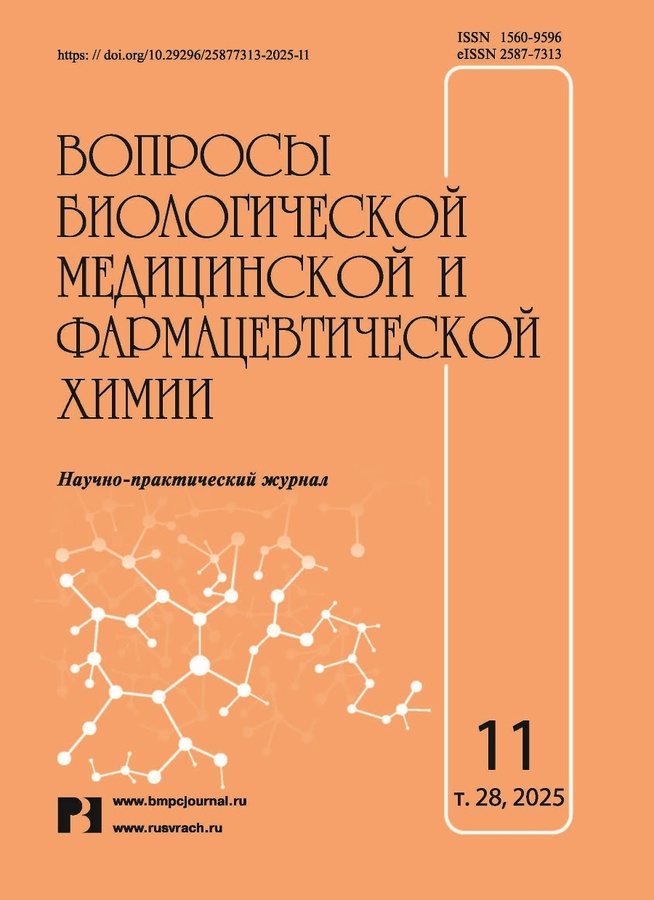Effect of acetone extract of Agrimonia Pilosa Ledeb. Leaves on amylase and lipase
- 作者: Sokolova E.V.1, Krol T.A.1, Baleev D.N.1
-
隶属关系:
- All-Russian Scientific Research Institute of Medicinal and Aromatic Plants
- 期: 卷 28, 编号 11 (2025)
- 页面: 46-49
- 栏目: Pharmaceutical chemistry
- URL: https://journals.eco-vector.com/1560-9596/article/view/696240
- DOI: https://doi.org/10.29296/25877313-2025-11-06
- ID: 696240
如何引用文章
详细
Introduction. In recent years, digestive enzymes for targeted action on metabolic pathways have attracted considerable interest. Medicinal plants are rich in various biologically active compounds and, compared to synthetic inhibitors, exhibit lower toxicity as inhibitory ligands of gastrointestinal enzymes. In food practice, the range of applications of Agrimonia pilosa Ledeb. leaf extracts may expand.
Objective. The purpose of the present investigation was aimed at studying the content of phenolic compounds including flavonoids in the A. pilosa leaf acetone extract followed by its influence on the activity of digestive enzymes (amylase and lipase).
Material and methods. In vitro methods using artificial substrates synthesized for specific interaction with lipase and amylase were used to determine the activity of pancreatic enzymes.
Results. Our results showed that the acetone extract of A. pilosa leaves enriched in polyphenolic compounds inhibited the activity of digestive enzymes in vitro models. Inhibition of amylase was more significant than lipase.
Conclusions. If the effect of A. pilosa on lipase has previously been the subject of study, according to literature data, then, to our knowledge, no such studies have been conducted on amylase, giving the results obtained novelty and opening up prospects for further research in this direction.
全文:
作者简介
E. Sokolova
All-Russian Scientific Research Institute of Medicinal and Aromatic Plants
编辑信件的主要联系方式.
Email: eka9739@yandex.ru
ORCID iD: 0000-0002-7605-9688
SPIN 代码: 3578-1374
Ph.D. (Biol.), Leading Research Scientist
俄罗斯联邦, 7 Grina str., Moscow, 117216T. Krol
All-Russian Scientific Research Institute of Medicinal and Aromatic Plants
Email: tatianakroll1@gmail.com
ORCID iD: 0000-0003-4642-651X
SPIN 代码: 1620-2290
Ph.D. (Agric.), Head of the Laboratory of Genomics and Biochemistry of Medicinal Plants
俄罗斯联邦, 7 Grina str., Moscow, 117216D. Baleev
All-Russian Scientific Research Institute of Medicinal and Aromatic Plants
Email: dbaleev@gmail.com
ORCID iD: 0000-0002-1228-0594
SPIN 代码: 5487-2926
Ph.D. (Agric.), Head of the Laboratory of Atomic-Molecular Bioregulation and Selection
俄罗斯联邦, 7 Grina str., Moscow, 117216参考
- Li Z., Tian J., Cheng Z. et al. Hypoglycemic bioactivity of anthocyanins: A review on proposed targets and potential signaling pathways. Critical reviews in food science and nutrition. 2023; 63(26): 7878–7895. doi: 10.1080/10408398.2022.2055526.
- Shen Y., Wang M., Zhou J. et al. Construction of Fe3O4@ α-glucosidase magnetic nanoparticles for ligand fishing of α-glucosidase inhibitors from a natural tonic Epimedii Folium. International Journal of Biological Macromolecules. 2020; 165: 1361–72. doi: 10.1016/j.ijbiomac.2020.10.018.
- Li Y.J., Wan G.Z., Xu F.C. et al. Screening and identification of α-glucosidase inhibitors from Cyclocarya paliurus leaves by ultrafiltration coupled with liquid chromatography-mass spectrometry and molecular docking. Journal of Chromatography A. 2022; 1675: 463160. doi: 10.1016/j.chroma.2022.463160.
- Park M.J., Kang Y.H. Isolation of Isocoumarins and Flavonoids as α-Glucosidase Inhibitors from Agrimonia pilosa L. Molecules. 2020 May 31; 25(11): 2572. doi: 10.3390/molecules25112572.
- Guo H., Chen Y., Song N. et al. Screening of lipase inhibitors from bamboo leaves based on the magnetic ligand fishing combined with HPLC/MS. Microchemical Journal. 2020; 153: 104497. doi: 10.1016/j.microc.2019.104497.
- de Almeida F.G., Vanzolini K.L., Cass Q.B. Angiotensin converting enzyme immobilized on magnetic beads as a tool for ligand fishing. Journal of Pharmaceutical and Biomedical Analysis. 2017; 132: 159–64. doi: 10.1016/j.jpba.2016.10.006.
- Meng J., Li Q., Cao Z. et al. Rapid screening and separation of active compounds against α-amylase from Toona sinensis by ligand fishing and high-speed counter-current chromatography. International Journal of Biological Macromolecules. 2021; 174: 270–277. doi: 10.1016/j.ijbiomac.2021.01.195.
- Liu D.M., Chen J., Shi Y.P. α-Glucosidase immobilization on chitosan-enriched magnetic composites for enzyme inhibitors screening. International journal of biological macromolecules. 2017; 105: 308–316. doi: 10.1016/j.ijbio-mac.2017.07.045.
- Wan G.Z., Ma X.H., Jin L., Chen J. α-glucosidase immobilization on magnetic core-shell metal-organic frameworks for inhibitor screening from traditional Chinese medicines. Colloids and Surfaces B: Biointerfaces. 2021; 205: 111847. doi: 10.1016/j.colsurfb.2021.111847.
- Jiang X., Qin Y., Wang X. et al. Enzyme immobilized on magnetic fluorescent bifunctional nanoparticles for α-glucosidase inhibitors virtual screening from Agrimonia pilosa Ledeb extracts accompanied with molecular modeling. Journal of Chromatography A. 2023; 1711: 464433. doi: 10.1016/j.chroma.2023.464433.
- Singleton V.L., Rossi J.A. Colorimetry of total phenolics with phosphomolybdic-phosphotungstic acid reagents. American journal of Enology and Viticulture. 1965; 16(3): 144–158. doi: 10.5344/ajev.1965.16.3.144.
- Ojha S., Raj A., Roy A., Roy S. Extraction of total phenolics, flavonoids and tannins from Paederia foetida L. Leaves and their relation with antioxidant activity. Pharmacognosy Journal. 2018; 10(3). doi: 10.5530/pj.2018.3.88.
- Chang C.C., Yang M.H., Wen H.M., Chern J.C. Estimation of total flavonoid content in propolis by two complementary colorimetric methods. Journal of food and drug analysis. 2002; 10(3).
- Mammen D., Daniel M. A critical evaluation on the reliability of two aluminum chloride chelation methods for quantification of flavonoids. Food chemistry. 2012; 135(3): 1365–1368. doi: 10.1016/j.foodchem.2012.05.109.
- Morishita Y., Iinuma Y., Nakashima N. et al. Total and pancreatic amylase measured with 2-chloro-4-nitrophenyl-4-O-β-D-galactopyranosylmaltoside. Clinical chemistry. 2000; 46(7): 928–933. doi: 10.1093/clinchem/46.7.928.
- Panteghini M., Bonora R., Pagani F. Measurement of pancreatic lipase activity in serum by a kinetic colorimetric assay using a new chromogenic substrate. Annals of clinical biochemistry. 2001; 38(4): 365–370. doi: 10.1258/0004563011900876.
- Cho N.H., Shaw J.E., Karuranga S. et al. IDF Diabetes Atlas: Global estimates of diabetes prevalence for 2017 and projections for 2045. Diabetes research and clinical practice. 2018; 138: 271–281. doi: 10.1016/j.diabres.2018.02.023.
- Chanu K.D., Sharma N., Kshetrimayum V. et al. Ageratina adenophora (Spreng.) King & H. Rob. Standardized leaf extract as an antidiabetic agent for type 2 diabetes: An in vitro and in vivo evaluation. Frontiers in Pharmacology. 2023; 14: 1178904. doi: 10.3389/fphar.2023.1178904.
- Wen S., Zhang X., Wu Y. et al. Agrimonia pilosa Ledeb.: a review of its traditional uses, botany, phytochemistry, pharmacology, and toxicology. Heliyon. 2022; 8(8).
- Lee Y.M., Kim Y.S., Lee Y. et al. Inhibitory activities of pancreatic lipase and phosphodiesterase from Korean medicinal plant extracts. Phytotherapy Research. 2012; 26(5): 778–782. doi: 10.1002/ptr.3644.
补充文件






